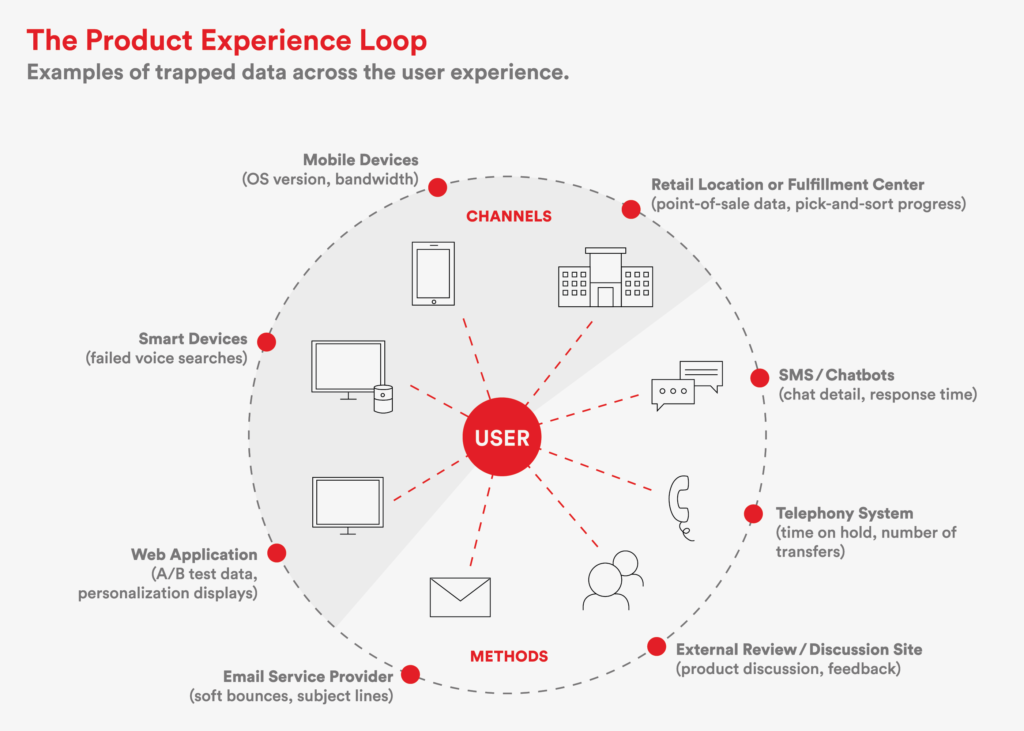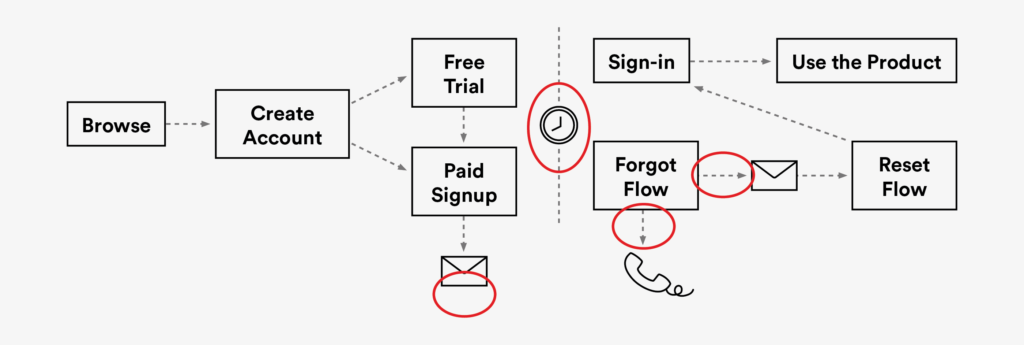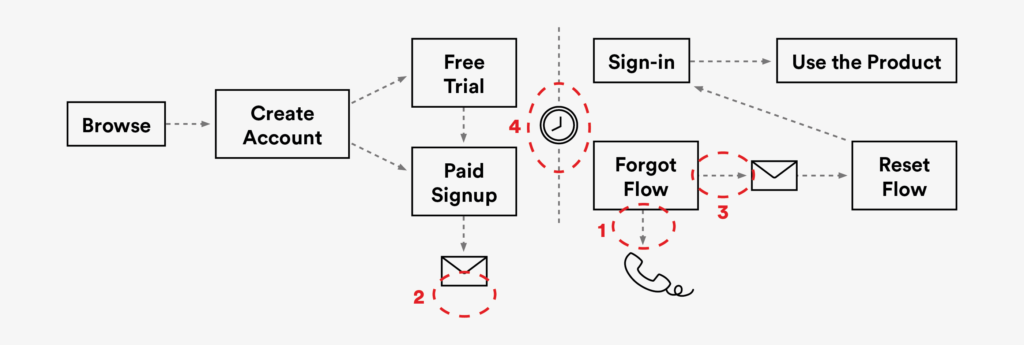
There are countless steps where the product experience can break down. Have you ever been waiting at the corner for a ride-sharing pickup, and while the app swears the driver is right there, there is no car in sight? Or how about seamlessly ordering groceries in an app, then waiting well past the delivery window with no sign of your avocados? Ever called customer service by phone to learn they have no record of the two detailed chats you had with online agents about your issue? We’ve all been there.
As consumers who increasingly rely on technology to help us wrangle a vast range of goods and services, we’ve all experienced pain points when really good software doesn’t equate a really good experience. All too often, there’s a breakdown that occurs outside product screens, when a product or process hits the reality of the human experience or a user fails.
Take a peek at the diagram above, which charts the various user touch points that can occur with your brand in a product experience loop. Users interact with a product through many different channels and modes of communication, and bridging the gaps between them is essential to your product’s success. If you present users with a custom call to action in a social media ad, your customer service teams must be ready to respond. If you build an offer email that is redeemable at a brick-and-mortar retail location, the cashier will need tools to redeem it.
Encountering any gaps in the product-experience loop is frustrating to the user and these points of friction jeopardize your businesses. I call these gaps mode-shift friction. Risks include the potential for lost revenue or increasing vulnerability to competitors who offer frictionless experience.
What Is Mode-Shift Friction?
Mode-shift friction encompasses any of the pain points that users encounter when they move between modalities within the same brand or product experience. These mode shifts include going from physical to digital channels, switching communication methods, changing the context of product use, inconsistency of functionality across different devices, and more.
Product teams are tasked with creating seamless digital experiences, but they frequently lack an empathetic transition from one mode to the next. This is often because internal organizational structures and processes put teams in charge of isolated parts of the experience, siloing them from one another as they work. The result? Each team optimizes to serve their needs best, making decisions that can be at odds with other teams, ultimately causing breaks in the experience flow.
Users don’t know and don’t care that responsibility is divided between teams; they will express their frustration by abandoning a product for one that is friendlier to use.
For this reason, it’s essential to resolve mode-shift friction wherever possible. The success of a product, and a business, can depend on it.
The History of Experience Mapping
The work to develop a comprehensive picture of a user’s experience is nothing new, and in the last few decades, several tools and methodologies have emerged that have become staples for product and design teams. The concept of service design goes as far back as bank executive G. Lynn Shostack’s 1984 Harvard Business Review article on measuring and improving the processes and services the bank delivered.
In the late 1990s, Amtrak asked design firm IDEO to help with the armchair design for a new high-speed rail service it was planning. As part of their observations, IDEO’s team mapped the steps of the journey users tooks to consider and ultimately purchase a seat on the train. And the journey map was born. Then more recently (though still a decade ago) a new form of mapping emerged when the design consultancy nForms introduced experience maps as part of an approach to deepening the relationship Comcast had with video gamers.
All of these approaches tackle macro focuses — process improvement, detailing a user’s emotional state, understanding the journey to drive the action. But as teams drill in to focus on a particular part of the journey, rifts start to appear between the swimlanes and linear process blocks that are depicted in these process documents. For example, the team optimizing for the conversion funnel may not have connected with the team optimizing the onboarding flow. So instead of a smooth transition, the user may have to disrupt or leave a more natural flow to check their email for a confirmation code.
As the lines get drawn, shifts in mode (between task/goal, system, process) can get ignored, creating mode-shift friction, and smart product teams need to delve into those crevices between the experience to create truly human experiences.
5 Steps to Easing Mode-Shift Friction
Creating a seamless experience overnight is unrealistic, because rethinking how different teams operate and connecting disparate software systems is a complex and time-consuming undertaking. However, improvement is absolutely possible if you take an iterative approach. I advocate for chipping away at the problem bit by bit. Don’t overcomplicate the solution with a new behemoth data warehouse project or rolling out company-wide process changes. Instead, try these five purposeful steps to identifying, quantifying, and beginning to eliminate mode-shift friction. They’re easy enough to start working into your very next sprint.
1. Find your gaps.
To identify the gaps in your experience, start with an experience or journey map you already have. If you don’t already have one, keep it simple and make a rough sketch of the major user flows of your product experience. Review these key flows with your customer-facing teams and start circling areas where a mode shift occurs. Maybe it’s when a user switches from an app to an email or call, or goes from buying to using a product. Focus on the gaps you all agree on, but prioritize and optimize the ones that front-line customer-facing teams think are the biggest issues. Name a product and operating team steward for each circle to ensure you have someone accountable for closing that gap.

In your next sprint: Gather up existing flows or take a first pass at sketching your flows. Identify the key stakeholders from across the organization, but especially from every customer-facing team. Begin circling your gaps.
2. Capture gap data.
Next, you’ll want to put numbers to these gap areas to start making sense of the possible routes you can take to begin optimizing. Some organizations have a role dedicated to this task, a user researcher who talks to users, facilitates the gathering of user insights, synthesizes the findings, and shares it with the team. If you don’t have a user researcher, you can still easily obtain information you need to help inform your decisions. Keep it simple and seek out qualitative data by having your team shadow and talk to users. Dog-fooding, a process in which teams actually using the product they build, may not always be practical. Deploy research tools like surveys and collective story harvests to start gathering the gap data.
Implement measuring tools on the software and hardware systems you do have, ideally with some universal identifier, and keep in mind that some of these systems may live outside of your product, like with a third-party CRM solution or telephone provider.
In your next sprint: Gather up the existing data for all the systems and ensure everyone can access it. Spend time with each customer-facing team and ask them what data they would love to have — it’s likely to illuminate a data gap you have. Best-case scenario: You can get teams the data they need and you’ve started solving some problems.
3. Track mode-shift triggers.
Once you have a good base of data, it’s time to start looking for patterns. What caused the user to change modes? Zero in on the triggers. Is it mismatched expectations? A channel preference? Is one mode more convenient than another? Does a time interval or pattern of repetition signal a mode shift? Look for patterns in the events that precede a shift.
Get the data scientist or analysts on your team to help derive insights from the data. If you don’t have someone in this role, you may be able to find an analyst in an unlikely place like your finance department; befriend them and enlist them to help. Then prioritize the gaps by looking at:
- The value for the user in solving the gap.
- The value to your business in reducing costs or generating new revenue.
- The order-of-magnitude effort to close the gap.
It’s helpful to look at both the qualitative and quantitative data so product managers can prioritize and make the best decisions.

In your next sprint: List out the top drivers of inbound and outbound volume for each of your channels. Look at what user activity immediately preceded a “contact us” search or action in your apps. Both of these likely are good indicators of mode-shift friction.
4. Fix the friction.
Now that you have prioritized the most egregious triggers, it’s time to start tackling the friction. Who should solve the problems? It depends. If the scope of the gap is discrete and small, it may make sense to extend the responsibilities of a team that manages the experience before or after that gap. Sometimes, you may find the gap is big enough that it warrants creating a new team dedicated to the solution, perhaps including someone from a different department as part of that team.
Keep in mind that the solution may not reside fully within the product team (or at all) since it might be an organization structure or process issue. If that’s the case, you won’t be able to stay within your product comfort zone, but will instead need to engage with your full organization on fixes. And even if you’re not responsible for a certain team outside your organization, it doesn’t mean you can’t have ownership of the resolution. To close the gap, then, make a plan and execute.
In your next sprint: Identify one gap you can close in less than 30 days. It doesn’t have to be software. Small changes can make an impact, such as improving a transactional email with more relevant data, or recording an interactive voice response (IVR) menu option to address a top pain point.
5. Close the loop.
The final step of the process is to work your way through the gaps by linking data sets for every single user interaction with a corresponding part of your ecosystem. This ensures you not only deliver an amazing product experience, but are also prepared to anticipate and detect new triggers — captured by fluctuations in data — along the way.
Mode-shift friction often arises because disparate systems are not connected, and while you want to strive to have all your systems and data linked, the reality is that you may have to live with multiple systems and data sources.
Still, there are easy steps you can take to get every team access to the disparate systems. It may be as simple as securing analytics accounts for necessary team members, and providing a training so individuals know how to use it. This way, even if they can’t get ahead of big issues, they are at least equipped to troubleshoot across your silos. Avoid the temptation to put off closing the loop while you wait for a master repository to house varying sets of data. Instead, start low-tech by simply sharing static data and reports across verticals. Interdepartmental dialogue is essential in eliminating mode-shift friction.
In your next sprint: Pick one customer-facing department and grant a subset of that team pilot access to a product system that addresses a key user pain point. Evaluate the effort (training, provisioning, etc.) versus the resolution metrics (e.g., issue resolution, handle time) to determine whether the system is helping, and if so, formulate a full rollout plan.
See, that wasn’t so hard.
The antidote to mode-shift friction is not terribly complex; at its heart lies the need to develop a comprehensive picture of what is happening with your users and to deliberately and intentionally design for the gaps across every step of the product life-cycle. Completing this product-experience loop will help you build better product experiences for the way humans actually use your your product. It will lead to happier users, greater brand loyalty, increased revenue, and longevity for your product.
When product teams lack insight into breakdowns in the user experience, they risk losing customers.
***
At General Assembly, learn how to build better products that customers will love. Make your company’s teams more efficient and cross-functional through expert-led training in product management, user experience design, and more. Through our innovative training and hiring programs, create effective teams with the right mix of talent needed to move your business forward. For individuals, learn human-centered design in our full-time or part-time UX design courses. Discover how to launch successful products in our part-time Product Management course.